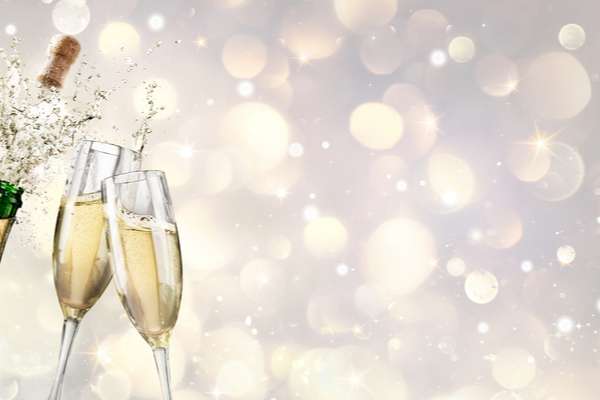National Champagne Day, celebrated annually on the most apropos day of the year – December 31 – is all about enjoying sipping on this bubbly beverage. New Year’s Eve is the perfect time for champagne lovers to celebrate, giving us an even better excuse to pop open a bottle — or two!
History of National Champagne Day
Before everyone was mentioning it with hashtags on social media, National Champagne Day was introduced in a few books during the mid-2000s. In 2007, the books “Practically Useless Information on Food,” and “Drink Wine Enthusiast” both recognized the holiday on August 4. However, National Champagne Day doesn’t have an official registration date. Since this bubbling drink is traditionally popped on New Year’s Eve, the majority of the world unwittingly celebrates it in that way!
After first appearing on Twitter in 2010, the hashtag #NationalChampagneDay has since increased in popularity, especially during December and January. Restaurants and alcohol traders take full advantage of this national holiday by hosting events centering around champagne to attract customers.
But where did champagne originate from? If you imagine yourself sipping it somewhere in the countryside of France, you’d be pretty accurate, because this sparkling wine does hail from north-eastern France’s “Champagne” region. It has transformed from originally being a pinkish, pale still wine to the sparkling one that is associated with the region today. The Romans planted the first champagne vineyards and had begun cultivating them by around the 5th century, or earlier.
After the death of Louis XIV of France in 1715, the court of the Duke of Orléans, Philippe II, made the sparkling version of champagne the drink of choice among the French aristocracy. During the 19th century, the modern champagne industry began to take shape. This period saw the establishment of several of today’s famous champagne houses, including Krug, Pommery, and Bollinger. However, the two World Wars in the early 20th century caused major stumbling blocks for the rise of this industry. The Russian and American champagne markets were also lost due to the Russian Revolution and Prohibition.
Fast forward to the modern era, and champagne’s popularity surged once again. The wine was once more associated with both extravagance and celebration, and sales quadrupled since 1950. Today, the Champagne region of France — made up of the Aube, Marne, Haute-Marne, and Ardennes departments — produces over 200 million bottles with a worldwide market, enticing French authorities to look into expanding the 86,5000-acre region to facilitate more production. In fact, they’ve cornered the market on it, literally, because only sparkling wine produced in the Champagne region is allowed to be labeled as such. In Spain, it’s known as Cava, in Italy, as Prosecco, and if it comes from California, it probably says, “Sparkling Wine” on the label. And that’s the law, folks!
More Champagne Fun Facts
- Millions of bubbles, literally. There are about 49 million bubbles inside a standard bottle of champagne.
- Bubbling fast. A standard size glass emits 30 bubbles every second.
- Pressure, pressure, pressure. The pressure in a champagne bottle is about three times the amount of pressure inside car tires.
- Carbonation upon carbonation. Champagne has three times more carbonation than beer.
- Winston Churchill loved it. Winston Churchill was one of the biggest champagne drinkers on record — between 1908 and 1965, the former British Prime Minister drank an estimated 42,000 bottles!
Cheers!
—
Photo Credit: Romolo Tavani / Shutterstock.com
